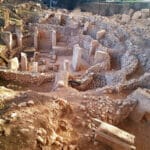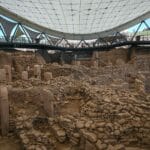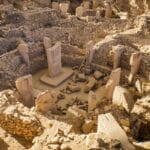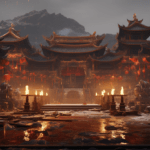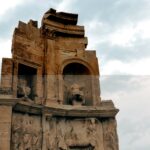Imagine a temple, older than Stonehenge, predating even the invention of pottery – a place where massive, intricately carved pillars stand as silent witnesses to a civilization lost in time. This is Göbekli Tepe, a remarkable archaeological site nestled in southeastern Anatolia, Turkey, that has captured the imagination of the world. Dating back to the Pre-Pottery Neolithic period (approximately 9500-8000 BCE), Göbekli Tepe rewrites the narrative of human history, challenging our understanding of early societies and their capabilities. But how can we begin to comprehend a culture so far removed from our own? The answer lies in the very stones themselves – in the captivating Göbekli Tepe images that offer us a glimpse into a time shrouded in mystery.
The Power of Images: A Window to the Past
While archaeological reports and scholarly interpretations are invaluable, Göbekli Tepe images provide a visceral connection to this ancient world. Photographs document the scale and grandeur of the site, capturing the towering T-shaped pillars, some reaching nearly 20 feet in height, arranged in circular enclosures. Aerial views, made possible by drones, reveal the site’s layout and its relationship to the surrounding landscape. High-resolution images bring to life the intricate carvings that adorn the pillars – a menagerie of animals, including foxes, snakes, boars, and birds, alongside enigmatic abstract symbols that continue to puzzle researchers.
But the power of Göbekli Tepe images extends beyond mere documentation. They allow us to connect with the artistry and skill of the people who created this site. The carvings, executed with precision using rudimentary stone tools, speak to a deep understanding of animal anatomy and a keen eye for detail. These images also hint at the potential beliefs and rituals practiced at Göbekli Tepe. Were the animals depicted totems representing different clans or deities? Do the abstract symbols hold a deeper meaning, perhaps relating to astronomical observations or early forms of writing? While definitive answers remain elusive, these images provide crucial clues as we piece together the puzzle of Göbekli Tepe.
Key Images and Their Significance
Let’s delve into a selection of compelling Göbekli Tepe images to uncover the stories they tell:
1. The Vulture Stone (Pillar 43): Perhaps the most iconic image from Göbekli Tepe, the Vulture Stone depicts a scene that has sparked endless speculation. Carved onto a pillar within Enclosure D, the image shows birds of prey, likely vultures, circling around a headless human figure. Some archaeologists interpret this as evidence of funerary rituals, with vultures playing a role in the disposal of the dead. Others suggest that the image holds deeper symbolic meaning, perhaps relating to death and rebirth.
[Image of the Vulture Stone]
2. Enclosure D: A Gathering Place: This image provides a panoramic view of Enclosure D, one of the best-preserved enclosures at Göbekli Tepe. It showcases the distinctive circular arrangement of the pillars, with two larger central pillars flanked by smaller stones. The carefully crafted stonework and the sheer scale of the structure suggest a high level of social organization and communal effort.
[Image of Enclosure D]
3. Fox Relief: This close-up image highlights the incredible detail of the animal carvings at Göbekli Tepe. The fox, rendered with anatomical accuracy, appears to be leaping or dancing. Animals are a recurring motif throughout the site, suggesting their importance to the people who built Göbekli Tepe.
[Image of Fox Relief]
4. Abstract Symbols: While the animal carvings are captivating, the abstract symbols found at Göbekli Tepe are equally intriguing. This image showcases a collection of these symbols, including geometric patterns, crescents, and what appear to be stylized human forms. Their meaning remains a subject of ongoing research and debate.
[Image of Abstract Symbols]
5. 3D Reconstruction: Modern technology is now allowing us to visualize Göbekli Tepe in ways never before imagined. This image shows a 3D reconstruction of Enclosure D, created using photogrammetry techniques. These reconstructions allow researchers and the public alike to virtually explore the site, gaining a sense of its scale and layout.
[Image of 3D Reconstruction of Enclosure D]
Göbekli Tepe Images: Challenging Assumptions
The discovery of Göbekli Tepe in the 1990s sent shockwaves through the archaeological community. Its sheer age and sophistication challenged the prevailing narrative of human history. Prior to Göbekli Tepe, it was widely believed that monumental architecture and complex societies emerged as a result of the Neolithic Revolution, the transition from hunter-gatherer lifestyles to settled agriculture. Göbekli Tepe, constructed by a hunter-gatherer society thousands of years before the advent of agriculture, upends this assumption. It suggests that our ancestors were capable of far greater social organization and technological innovation than previously thought possible.
Göbekli Tepe images play a crucial role in fueling this ongoing debate. They provide visual evidence of the site’s complexity, sparking discussion and prompting new theories about its purpose and significance. Was Göbekli Tepe a religious center, a place where people gathered for rituals and ceremonies? Did it serve as a meeting place for different hunter-gatherer groups, fostering social cohesion and exchange? Or could it have been an astronomical observatory, its pillars aligned with the stars? While definitive answers remain elusive, the ongoing study of Göbekli Tepe images, combined with archaeological excavations, promises to shed further light on this enigmatic site and its creators.
The Future of Göbekli Tepe Images
As excavations and research at Göbekli Tepe continue, new discoveries are continually reshaping our understanding of the site. Göbekli Tepe images, both traditional photographs and cutting-edge 3D models, play a vital role in documenting these discoveries and making them accessible to a global audience.
Advancements in technology, such as photogrammetry, laser scanning, and virtual reality, are revolutionizing the way we experience and interact with archaeological sites like Göbekli Tepe. Photogrammetry allows for the creation of highly detailed 3D models from photographs, providing precise measurements and preserving the site in digital form. Laser scanning captures even finer details, allowing researchers to identify tool marks on the stonework and analyze the carvings with unprecedented accuracy. Virtual reality takes this a step further, immersing viewers in a 3D reconstruction of the site, allowing them to virtually walk among the pillars and experience Göbekli Tepe as it might have been thousands of years ago.
These technologies not only enhance our understanding of Göbekli Tepe but also make the site more accessible to people who may not be able to visit in person. Virtual tours, interactive websites, and online databases of Göbekli Tepe images are bringing the wonders of this ancient world to a global audience, inspiring awe and curiosity about our shared human past.
Conclusion
The enigmatic pillars and intricate carvings of Göbekli Tepe stand as a testament to the ingenuity and creativity of our distant ancestors. Göbekli Tepe images, from the iconic Vulture Stone to detailed close-ups of animal reliefs, offer us a captivating window into a world lost to time. They spark our imaginations, challenge our assumptions, and remind us of the enduring power of human ingenuity. As we continue to explore the mysteries of Göbekli Tepe through the lens of archaeology and the power of imagery, we gain a deeper appreciation for the complexities of our shared human story and the remarkable achievements of those who came before us.
- Revolution Space: Disruptive Ion Propulsion Transforming Satellites - April 24, 2025
- Race Through Space: Fun Family Game for Kids - April 24, 2025
- Unlocking the Universe: reading about stars 6th grade Guide - April 24, 2025

